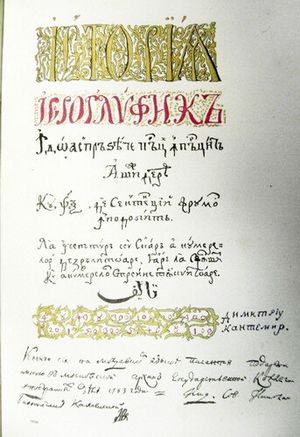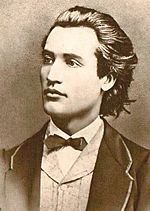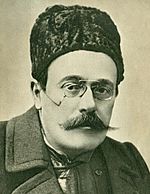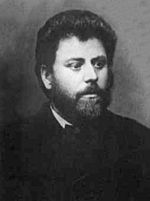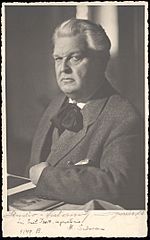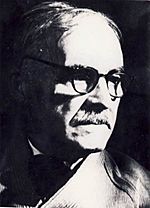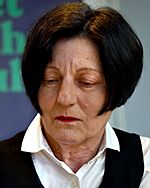Romanian literature facts for kids
Romanian literature (Romanian: Literatura română) is literature written by Romanian authors, although the term may also be used to refer to all literature written in the Romanian language or by any authors native to Romania.
Contents
History
The development of the Romanian literature took place in parallel with that of a rich Romanian folklore - lyric, epic, dramatic and didactic - which continued in modern times. The Romanian oral literature includes doine (lyric songs), balade (ballads), hore (dance songs), colinde (carols), basme (fairy tales), snoave (anecdotes), vorbe (proverbs), and ghicitori (riddles).
Medieval Slavonic Literature
The Script of Old Church Slavonic began to be used in the territories of current day Romania as early as the 10th Century, with the oldest surviving manuscripts being dated as far back as the 12th Century. The Earliest dated texts in Slavonic originally from Wallachia and Moldavia consist of a series of Religious Songs by Nicodim & Filotei and a Hagiographical text by Grigore Țamblâc, all being dated between 1385 and 1391. Also by the 15th century many copies of meddieval Slavonic texts have been created by the scribes of the Danubian Principalities.
In the meantime, numerous translations in Slavonic and Greek of popular Medieval romances were in circulation across the Danubian Principalities, like the Alexander Romance and Barlaam and Josaphat.
Particulatly of notice is "The Teachings of Neagoe Basarab to his son Theodosie," a series of teachings on Morality and Politics, written between 1519 and 1521, by the Wallachian Lord Neagoe Basarab, a work written within the spirit of the Renaissance and considered one of the Oldest great works of South-Eastern European Literature.
Beginning of Writing and Publishing in Romanian
The earliest surviving document in Romanian is Neacșu's Letter written in 1521, to the jude ("judge and mayor") of Brașov, Hans Benkner.
The earliest books in Romanian were translated from Slavonic religious texts in the 15th century. The Psalter of Șchei (Psaltirea Șcheiană) of 1482 and the Voroneț Codex (Codicele Voronețean) are religious texts that were written in Maramureș.
The first book printed in the Romanian Principalities was a Slavonic religious book in 1508 at Dealu Monastery. The first book printed in the Romanian language was a Protestant catechism of Deacon Coresi in 1559, printed by Filip Moldoveanul. Other translations from Greek and Slavonic books were printed later in the 16th century. Dosoftei, a Moldavian Bishop, in 1673, published the first Romanian metrical psalter, the earliest collection of poems written in Romanian.

Early efforts to publish the Bible in Romanian started with the 1582 printing in the small town of Orăștie of the so-called Palia de la Orăștie – a translation of the first books of the Old Testament - by Deacon Șerban (a son of the above-mentioned Deacon Coresi) and Marien Diacul (Marien the Scribe). Palia was translated from Latin by Bishop Mihail Tordaș et al., the translation being checked for accuracy using Hungarian translations of the Bible.
The entire Bible was not published in Romanian until the end of the 17th century, when the Metropolitanate's Press of Bucharest printed "Biblia de la București – "The Bucharest Bible" in 1688, compiled by the Greceanu Brothers.
In Transylvania, there was also an attestation of the explicit use of a Latin model, with the appearance of the first Romanian dictionary, Dictionarium Valachico-Latinum (Caransebeș, about 1650), while the first grammar of the Romanian language written in Latin was Institutiones linguae Valachicae (Crișana, circa 1770).
Humanism
Humanism in Moldavia and Wallachia can be first observed in 16th century with the likes of Luca Stroici and Petru Cercel, but it took one more century, for these to fully flourish. The reasons are for it can be, on one hand, the cultural continuity of the Romanian Principalities with Byzantine Culture or the different Social classes when compared to Western Europe.
Durring the 17th century via Poland and its Jesuit Schools, having as representatives the likes of Grigore Ureche, Miron Costin and Ion Neculce with their chronicles on the history of Moldavia.Following the example of Petro Movilă's Kyiv Colegium, the Lords, Matei Basarab and Vasile Lupu, established Neoclassical schools such as Schola Graeca et Latina and the Iași Colegiu.
The most significant Romanian Humanist was Dimitrie Cantemir, who wrote histories of Wallachia, Moldavia and the Ottoman Empire, and philosophical and religious treaties such as "the Divan," "The indescribable image of sacred science" or "The little compendium of logic." Wile also writting in 1705 the Roman à clef "A Hieroglyphic History."
National awakening
As the revolutionary ideas of nationalism spread in Europe, they were also used by the Romanians, who desired their own national state, but were living under foreign rule. Many Romanian writers of the time were also part of the national movement and participated in the revolutions of 1821 and 1848. The Origin of the Romanians began to be discussed and in Transylvania, a Latinist movement, Școala Ardeleană, emerged, producing philological studies about the Romanic origin of Romanian and opening Romanian language schools.
Romanians studied in France, Italy, and Germany, and German philosophy and French culture were integrated into modern Romanian literature, lessening the influence of Ancient Greece and the Orient over time. In Wallachia an important figure of the time was Ion Heliade Rădulescu, who founded the first Romanian-language journal and the Philharmonic Society, which later created the National Theatre of Bucharest.
The most important writers of the second half of the century were Vasile Alecsandri and later Mihai Eminescu. Alecsandri was a prolific writer, contributing to Romanian literature with poetry, prose, several plays, and collections of Romanian folklore. Eminescu is considered by most critics to be the most important and influential Romanian poet. His lyric poetry had many of its roots in Romanian traditions, but was also influenced by German philosophy and Hindu traditions.
Titu Maiorescu's Junimea literary circle, founded in 1863 and frequented by many Romanian writers, played an important role in Romanian literature. Many outstanding Romanian writers, including Ion Luca Caragiale, who wrote some of the best Romanian comedies, Ion Creangă, who wrote traditional Romanian stories and Barbu Ştefănescu Delavrancea, published their works during this time. George Coșbuc was a poet, translator, teacher, and journalist, best known for his verses describing, praising and eulogizing rural life. Nicolae Bălcescu, Dimitrie Bolintineanu, Alecu Russo, Nicolae Filimon, Bogdan Petriceicu Hasdeu, Alexandru Odobescu, Grigore Alexandrescu, Constantin Negruzzi, Alexandru Vlahuță, Alexandru Macedonski, Petre Ispirescu, Duiliu Zamfirescu, and Ioan Slavici are also important literary personalities of the era.
Interbellum literature
After achieving national unity in 1918, Romanian literature entered what can be called a golden age, characterized by the development of the Romanian novel. Traditional society and recent political events influenced works such as Liviu Rebreanu's Răscoala ("The Uprising"), which, published in 1932, was inspired by the 1907 Romanian Peasants' Revolt, and Pădurea Spânzuraților ("Forest of the Hanged"), published in 1922 and inspired by Romanian participation in World War I. The dawn of the modern novel can be seen in Hortensia Papadat-Bengescu (Concert din muzică de Bach—"Bach Concert"), Camil Petrescu (Ultima noapte de dragoste, întâia noapte de război—"The Last Night of Love, the First Night of War"). George Călinescu is another complex personality of Romanian literature: novelist, playwright, poet, literary critic and historian, essayist, journalist. He published authoritative monographs about Eminescu and Creangă, and a monumental (almost 1,000 pages in quarto) history of Romanian literature from its origin to the time of his writing (1941).
An important realist writer was Mihail Sadoveanu, who wrote mainly novels which took place at various times in the history of Moldova. But probably the most important writers were Tudor Arghezi, Lucian Blaga, and Mircea Eliade. Arghezi revolutionized Romanian poetry 50 years after Eminescu, creating new pillars for the modern Romanian poem. Blaga, one of the country's most important artistic personalities, developed through his writings a complex philosophic system, still not perfectly understood even today. Eliade is today considered the greatest historian in the field of religions. His novels reveal a mystical, pre-Christian symbolism paving the way for contemporary Romanian art.
Born in Romania, Tristan Tzara, a poet and essayist, is the main founder of Dada, a nihilistic revolutionary movement in the arts, and may have been responsible for its name (Romanian for "Yes yes"). Later he abandoned nihilism for Surrealism and Marxism. For the first time in its history, Romanian culture was fully connected to Western culture, while Dadaism is the first Romanian artistic and literary movement to become international. Dadaism and Surrealism are fundamental parts of the avant-garde, the most revolutionary form of modernism. The Romanian avant garde is very well represented by Ion Minulescu, Gherasim Luca, Urmuz, Perpessicius, Tristan Tzara, Grigore Cugler, Geo Bogza, Barbu Fundoianu, Gellu Naum, Ilarie Voronca, and Ion Vinea. Max Blecher was a poet whose life was cut short by health problems.
George Bacovia was a symbolist poet. While he initially belonged to the local Symbolist movement, his poetry came to be seen as a precursor of Romanian Modernism. Some important literary figures of this period were also active in other domains. Vasile Voiculescu was a Romanian poet, short-story writer, playwright, and physician. Ion Barbu was a poet, as well as an important mathematician.
Cezar Petrescu was a journalist, novelist, and children's writer. He is especially remembered for his children's book Fram, ursul polar ("Fram, the polar bear"; the circus animal character was named after Fram, the ship used by Fridtjof Nansen on his expeditions). Elena Farago was also a children's writer and poet.
Ion Agârbiceanu was a writer, as well as a politician, theologian and Greek-Catholic priest. Gala Galaction was another writer, who was also an Eastern Orthodox clergyman and theologian.
Other literary figures of this era include Ionel Teodoreanu, Panait Istrati, Gib Mihăescu, Otilia Cazimir, and George Topîrceanu.
Communist Era
Marin Preda is often considered the most important post-World War II Romanian novelist. His novel, Moromeții ("The Moromete Family"), describes the life and difficulties of an ordinary peasant family in pre-war Romania and later during the advent of Communism in Romania. His most important book remains Cel mai iubit dintre pământeni ("The Most Beloved of Earthlings"), a cruel description of communist society. Zaharia Stancu published his first important novel, Desculț (Barefoot), in 1948.
Some of the most important poets are Nichita Stănescu, Marin Sorescu, Ana Blandiana, Leonid Dimov, and Ștefan Augustin Doinaș. An important novelist of this era was Radu Tudoran.
Outside Romania, Eugène Ionesco and Emil Cioran represented the national spirit at the highest level. Ionesco is one of the foremost playwrights of the Theatre of the Absurd; beyond ridiculing the most banal situations, Ionesco's plays depict in a tangible way the solitude of humans and the insignificance of one's existence. Cioran was a writer and philosopher.
Contemporary literature
Some Romanian contemporary writers:
- Gabriela Adameșteanu
- Ștefan Agopian
- Radu Aldulescu
- Nicolae Breban
- Svetlana Cârstean
- Mircea Cărtărescu
- Traian T. Coșovei
- Gheorghe Crăciun
- Alexandru Ecovoiu
- Radu Pavel Gheo
- Ioan Groșan
- Florin Iaru
- Claudiu Komartin
- Ion Bogdan Lefter
- Norman Manea
- Dan C. Mihăilescu
- Grid Modorcea
- Herta Müller (2009 Nobel Laureate)
- Ion Mureșan
- Mircea Nedelciu
- Ioana Pârvulescu
- Dora Pavel
- Dumitru Radu Popescu
- Simona Popescu
- Sorin Preda
- Doina Ruști
- Tudor Dumitru Savu
- Dan Sociu
- Cecilia Ștefănescu
- Ion Stratan
- Bogdan Suceavă
- Cristian Teodorescu
- Dumitru Țepeneag
Chronology: 19th century-present day
- 1812 Țiganiada Ioan Budai-Deleanu (epic poem)
- 1847 Povestea vorbii Anton Pann (narrative poem)
- 1850 Cântarea României Alecu Russo (epic poetry)
- 1857 Alexandru Lăpușneanul Costache Negruzzi (historical novel)
- 1861-1863, posthoumously Românii supt Mihai-Voievod Viteazul Nicolae Bălcescu (historical non-fiction)
- 1867 Răzvan și Vidra Bogdan Petriceicu Hasdeu (play)
- 1879 Amintiri din copilărie Ion Creangă (autobiographical novel)
- 1883 Poezii Mihai Eminescu (poetry)
- 1884 O Scrisoare Pierdută I.L. Caragiale (play)
- 1894 Mara Ioan Slavici (novel)
- 1920 Ion Liviu Rebreanu (novel)
- 1924 În Marea Trecere Lucian Blaga (poetry)
- 1925 Danton Camil Petrescu (play)
- 1927 Concert din Muzică de Bach Hortensia Papadat-Bengescu (novel)
- 1927 Cuvinte Potrivite Tudor Arghezi (poetry)
- 1929 Craii de Curtea-Veche Mateiu Caragiale (novel)
- 1930 Joc Secund Ion Barbu (poetry)
- 1933 Patul lui Procust Camil Petrescu (novel)
- 1934 Ioana Anton Holban (novel)
- 1936 Întâmplări în Irealitate Imediată Max Blecher (novel)
- 1938 Enigma Otiliei George Călinescu (novel)
- 1943 Panopticum Ion Caraion (poetry)
- 1945 Plantații Constant Tonegaru (poetry)
- 1946 Stanțe Burgheze George Bacovia (poetry)
- 1946 Libertatea de a Trage cu Pușca Geo Dumitrescu (poetry)
- 1947 Don Juana Radu Stanca (play)
- 1955 Moromeții Marin Preda (novel)
- 1956 Primele Iubiri Nicolae Labiș (poetry)
- 1964 Ultimele sonete închipuite ale lui Shakespeare Vasile Voiculescu (poetry)
- 1965 Iarna Bărbaților Ștefan Bănulescu (short prose)
- 1966 Omul cu Compasul Ștefan Augustin Doinaș (poetry)
- 1966 11 Elegii Nichita Stănescu (poetry)
- 1968 Iona Marin Sorescu (play)
- 1969 Carte de Vise Leonid Dimov (poetry)
- 1969 Dicționar onomastic Mircea Horia Simionescu (novel)
- 1970 Matei Iliescu Radu Petrescu (novel)
- 1973 Vânătoarea Regală Dumitru Radu Popescu (novel)
- 1975 Lumea în Două Zile George Bălăiță (novel)
- 1977 Cartea de la Metropolis Ștefan Bănulescu (novel)
- 1977 Bunavestire Nicolae Breban (novel)
- 1980 Faruri, Vitrine, Fotografii Mircea Cărtărescu (poetry)
- 1983 Dimineață Pierdută Gabriela Adameșteanu (novel)
- 1983 Poeme de Amor Mircea Cărtărescu (poetry)
- 1988 versuri vechi, nouă Mircea Ivănescu (poetry)
- 1989 Și Ieri Va Fi o Zi Mircea Nedelciu (short prose)
- 1990 Levantul Mircea Cărtărescu (epic poem)
- 1993 Nostalgia Mircea Cărtărescu (short prose)
- 1996 Amantul Colivaresei Radu Aldulescu (novel)
- 1996 Coaja lucrurilor, sau Dansând cu Jupuita Adrian Oțoiu (novel)
- 1996 Orbitor. Aripa stângă Mircea Cărtărescu (novel)
- 2004 Omulețul roșu Doina Ruști (novel)
- 2004 Pupa Russa Gheorghe Crăciun (novel)
- 2004 Proorocii Ierusalimului Radu Aldulescu (novel)
- 2006 Zogru Doina Ruști (novel)
- 2008 Fantoma din moară Doina Ruști (novel)
- 2009 Lizoanca la 11 ani Doina Ruști (novel)
- 2015 Manuscrisul fanariot Doina Ruști (novel)
- 2017 Mâța Vinerii/The Book of Perilous Dishes Doina Ruști (novel)
- 2010 Rădăcina de bucsau Ovidiu Nimigean (novel)
- 2018 Armaghedon revelat Grid Modorcea (novel)
Translations of Romanian literature
- "Testament - Anthology of Modern Romanian Verse - Bilingual Edition - English/Romanian" (Daniel Ioniță, with Eva Foster and Daniel Reynaud; Editura Minerva 2012 - ISBN: 978-973-21-0847-5). This presents a comprehensive selection of Romanian poetry from 1850 to the present (post 2010) covering 56 poets and over 75 poems. It includes classics such as Vasile Alecsandri, Mihai Eminescu, Ion Minulescu, George Coșbuc, Tudor Arghezi, Vasile Voiculescu, Nicolae Labiș, as well as contemporaries such as Nichita Stănescu, Ana Blandiana, Marin Sorescu, Nora Iuga, Cezar Ivănescu, Ileana Mălăncioiu, Adrian Păunescu, George Tarnea, Mircea Cărtărescu, Daniel Banulescu, Lucian Vasilescu, Adrian Munteanu, Ioan Es. Pop, Liliana Ursu, Doina Uricariu, and others. The volume is prefaced by literary critic and historian Alex Ștefănescu.
- " The Disheveled Maidens" (Hortensia Papadat-Bengescu, Romanian Cultural Institute Publishing House 2004)
- "Something is still present and isn't, of what's gone. - A Bilingual Anthology of Avant-Garde and Avant-Garde Inspired Rumanian poetry - English/Rumanian" (Victor Pambuccian; Aracne editrice, Rome 2018 - ISBN: 978-88-255-1473-5). It includes poems of Tristan Tzara, B. Fundoianu, Ilarie Voronca, Geo Bogza, Max Blecher, Gherasim Luca, Gellu Naum, Geo Dumitrescu, Paul Celan, Ion Caraion, Nora Iuga, Nichita Stănescu, George Almosnino, Constantin Abăluță, Vintilă Ivănceanu, Daniel Turcea, Mariana Marin. The volume is prefaced by literary critic and historian of the Romanian avant-garde Mădălina Lascu.
See also
 In Spanish: Literatura de Rumania para niños
In Spanish: Literatura de Rumania para niños
- List of Romanian novelists
- List of Romanian writers



